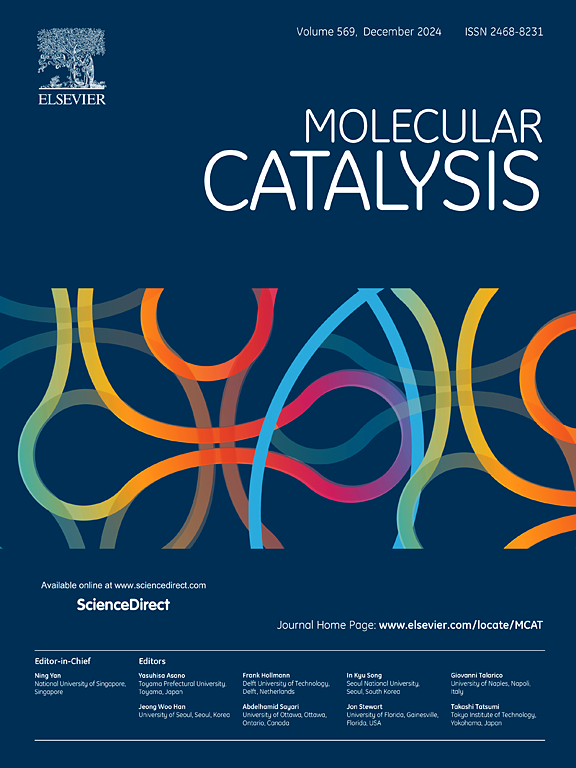利用铜基催化剂去除烟气中NO和CO污染物的方法和策略综述:机理和性能
IF 3.9
2区 化学
Q2 CHEMISTRY, PHYSICAL
引用次数: 0
摘要
随着工业化进程的迅速加快,氮氧化物(NOx)和一氧化碳(CO)的排放已成为一个紧迫的全球环境问题,对生态系统和人类健康构成重大威胁。铜基催化剂以其丰富的可用性、低廉的成本和优异的催化性能在多污染物协同处理领域受到了广泛的关注。本文综述了近年来铜基催化剂在烟气中NOx和CO脱除方面的研究进展,重点介绍了铜基催化剂在选择性催化还原(SCR)、CO催化氧化和双功能共催化方面的应用。通过深入分析影响催化性能的关键因素,如价态调制、形态结构设计、制备方法优化、辅助掺杂和金属配比调整等,阐明了各种催化剂性能的关键作用。这些指标包括氧化还原能力、酸性、表面氧空位浓度和催化过程中的活性位点分散。此外,本文还详细探讨了几种脱除NOx和CO策略中铜基催化剂的反应机理和耐硫性能,强调了双功能催化剂同时脱除NOx和CO的潜力。通过优化铜基催化剂的制备工艺、金属间相互作用和结构设计,在提高铜基催化剂的低温活性和稳定性方面取得了重大进展。这些进展为未来环境处理技术的发展提供了重要的理论见解和实践指导,为更有效和可持续的解决方案铺平了道路,以应对全球污染挑战。本文章由计算机程序翻译,如有差异,请以英文原文为准。

A review of methods and strategies for NO and CO pollutant removal from flue gas using copper-based catalysts: Mechanisms and performance
With the rapid acceleration of industrialization, the emission of nitrogen oxides (NOx) and carbon monoxide (CO) has emerged as a pressing global environmental issue, posing significant threats to ecosystems and human health. Copper-based catalysts have garnered substantial attention in the field of multi-pollutant synergistic treatment due to their abundant availability, low cost, and superior catalytic performance. This paper provides a comprehensive review of the recent advancements in copper-based catalysts for the removal of NOx and CO from flue gas, with a focus on their applications in selective catalytic reduction (SCR), CO catalytic oxidation, and bifunctional co-catalysis. Through an in-depth analysis of key factors influencing catalytic performance—such as valence modulation, morphological structure design, optimization of preparation methods, auxiliary doping, and adjustment of metal ratios—the critical roles of various catalyst properties are elucidated. These include redox capabilities, acidic nature, surface oxygen vacancy concentration, and active site dispersion in the catalytic process. Furthermore, this paper explores in detail the reaction mechanisms and sulfur-resistant properties of copper-based catalysts employed in several strategies for NOx and CO removal, highlighting the potential of bifunctional catalysts for simultaneous NOx and CO abatement. Significant progress has been achieved in enhancing low-temperature activity and stability through the optimization of preparation processes, intermetallic interactions, and structural design of copper-based catalysts. These advancements provide crucial theoretical insights and practical guidance for the development of future environmental treatment technologies, paving the way for more efficient and sustainable solutions to address global pollution challenges.
求助全文
通过发布文献求助,成功后即可免费获取论文全文。
去求助
来源期刊

Molecular Catalysis
Chemical Engineering-Process Chemistry and Technology
CiteScore
6.90
自引率
10.90%
发文量
700
审稿时长
40 days
期刊介绍:
Molecular Catalysis publishes full papers that are original, rigorous, and scholarly contributions examining the molecular and atomic aspects of catalytic activation and reaction mechanisms. The fields covered are:
Heterogeneous catalysis including immobilized molecular catalysts
Homogeneous catalysis including organocatalysis, organometallic catalysis and biocatalysis
Photo- and electrochemistry
Theoretical aspects of catalysis analyzed by computational methods
 求助内容:
求助内容: 应助结果提醒方式:
应助结果提醒方式:


